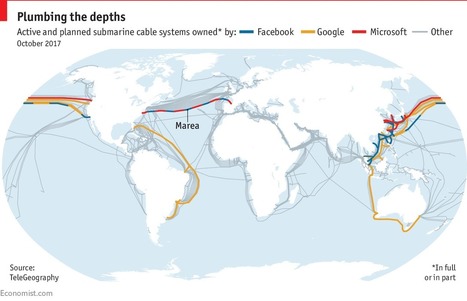Google, Facebook and Microsoft want more control over the internet’s basic infrastructure
ON SEPTEMBER 21st Microsoft and Facebook announced the completion of a 6,600km (4,100-mile) cable stretching from Virginia Beach, Virginia, to Bilbao, Spain. Dubbed Marea, Spanish for “tide”, the bundle of eight fibre-optic threads, roughly the size of a garden hose, is the highest-capacity connection across the Atlantic Ocean. It is capable of transferring 160 terabits of data every second, the equivalent of more than 5,000 high-resolution movies.
Such ultra-fast fibre networks are needed to keep up with the torrent of data flowing around the world. In 2016 international bandwidth usage reached 3,544 terabits per second, roughly double the figure in 2014. Firms such as Google, Facebook and Microsoft used to lease all of their international bandwidth from carriers such as BT or AT&T. Now they need so much network capacity to synchronise data across their networks of data centres around the world that it makes more sense to lay their own dedicated pipes.
This has led to a boom in new undersea cable systems. The Submarine Telecoms Forum, an industry body, reckons that 100,000km of submarine cable was laid in 2016, up from just 16,000km in 2015. TeleGeography, a market-research firm, predicts that $9.2bn will be spent on such cable projects between 2016 and 2018, five times as much as in the previous three years.



 Your new post is loading...
Your new post is loading...













After DataCenter infrastructure (through OCP open-source hardware), Tech companies drill down further the value chain and hit sea bottom with fiber. Software is indeed eating the world yet leads to hardware...